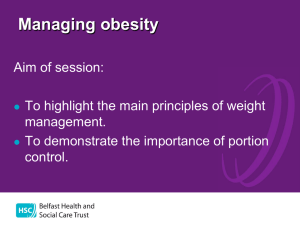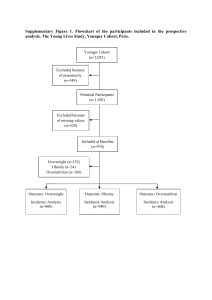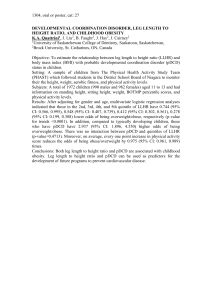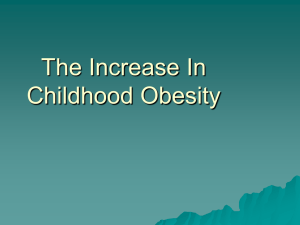Research Title - NewsCenter - San Diego State University
advertisement
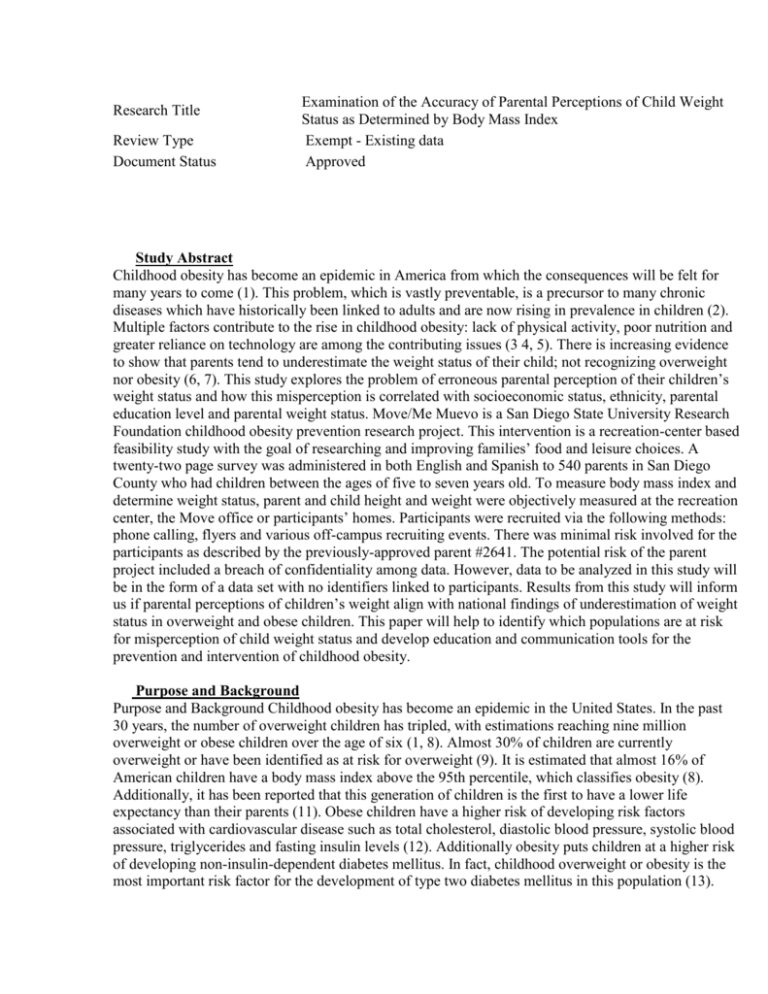
Research Title Review Type Document Status Examination of the Accuracy of Parental Perceptions of Child Weight Status as Determined by Body Mass Index Exempt - Existing data Approved Study Abstract Childhood obesity has become an epidemic in America from which the consequences will be felt for many years to come (1). This problem, which is vastly preventable, is a precursor to many chronic diseases which have historically been linked to adults and are now rising in prevalence in children (2). Multiple factors contribute to the rise in childhood obesity: lack of physical activity, poor nutrition and greater reliance on technology are among the contributing issues (3 4, 5). There is increasing evidence to show that parents tend to underestimate the weight status of their child; not recognizing overweight nor obesity (6, 7). This study explores the problem of erroneous parental perception of their children’s weight status and how this misperception is correlated with socioeconomic status, ethnicity, parental education level and parental weight status. Move/Me Muevo is a San Diego State University Research Foundation childhood obesity prevention research project. This intervention is a recreation-center based feasibility study with the goal of researching and improving families’ food and leisure choices. A twenty-two page survey was administered in both English and Spanish to 540 parents in San Diego County who had children between the ages of five to seven years old. To measure body mass index and determine weight status, parent and child height and weight were objectively measured at the recreation center, the Move office or participants’ homes. Participants were recruited via the following methods: phone calling, flyers and various off-campus recruiting events. There was minimal risk involved for the participants as described by the previously-approved parent #2641. The potential risk of the parent project included a breach of confidentiality among data. However, data to be analyzed in this study will be in the form of a data set with no identifiers linked to participants. Results from this study will inform us if parental perceptions of children’s weight align with national findings of underestimation of weight status in overweight and obese children. This paper will help to identify which populations are at risk for misperception of child weight status and develop education and communication tools for the prevention and intervention of childhood obesity. Purpose and Background Purpose and Background Childhood obesity has become an epidemic in the United States. In the past 30 years, the number of overweight children has tripled, with estimations reaching nine million overweight or obese children over the age of six (1, 8). Almost 30% of children are currently overweight or have been identified as at risk for overweight (9). It is estimated that almost 16% of American children have a body mass index above the 95th percentile, which classifies obesity (8). Additionally, it has been reported that this generation of children is the first to have a lower life expectancy than their parents (11). Obese children have a higher risk of developing risk factors associated with cardiovascular disease such as total cholesterol, diastolic blood pressure, systolic blood pressure, triglycerides and fasting insulin levels (12). Additionally obesity puts children at a higher risk of developing non-insulin-dependent diabetes mellitus. In fact, childhood overweight or obesity is the most important risk factor for the development of type two diabetes mellitus in this population (13). The rate of newly diagnosed cases of type two childhood obesity approaches nearly 45% (14). Multiple factors are attributed to the growing problem of childhood obesity. Recently, studies have started to investigate how parents view their children regarding their weight status. It has been shown that it is common for parents to underestimate the weight status of their child (7, 15, 16). Additionally, studies have found that parental concern for their child’s future is a function of the weight of the child, with concern increasing with the child’s BMI (7). Parental support in lifestyle interventions aimed at improving child weight status is fundamental (16). Thus, it is crucial that parents become more aware of how to correctly identify overweight or risk for overweight and make appropriate lifestyle changes if necessary. However, parental apprehension seems to be more linked with social variables (i.e. teasing by peers) rather than the child’s frame size (17). Perception of child weight status differs as a function of socioeconomic status, ethnicity, parental education level and parental weight status (18, 19, 20). The purpose of this study is to explore the accuracy with which parents perceive the weight status of their child. This misperception may impede prevention and/or treatment if the child is overweight, obese or at risk for these conditions. AIMS: a. Specific aims The purpose of this study will be to evaluate the correlation and accuracy between parental perception of child weight status and child body mass index (BMI). This study aims to: 1. Explore the accuracy of parental perceptions of child weight status as compared with child BMI. Hypothesis 1: Parents who have a child with a body mass index above the 85th percentile will underestimate the weight status of their child. 2. Examine the correlations between parental educational levels and accuracy of parental perception of child weight status. Hypothesis 2: Parents who have a lower educational level will underestimate the weight status of their child as compared to parents with more education. 3. Examine the correlations between socioeconomic factors and the accuracy of parental perception of child weight status. Hypothesis 3: Parents who are of a lower socioeconomic status will underestimate the weight status of their child as compared to parents with a higher SES. 4. Examine the correlations among various ethnic groups and the accuracy of parental perception of child weight status. Hypothesis 4: Parents who belong to ethnic minorities will underestimate the weight status of their child as compared to parents who do not belong to ethnic minorities. 5. Examine the correlation between parental weight status and parental perception of child weight status. Hypothesis 5: Parents who are of a higher weight status (i.e. overweight or obese) will underestimate the weight status of their child as compared to parents who weight less (i.e. neither overweight nor obese.) Data, Documents,Records and Specimens The data source was the MOVE/Me Muevo study, a randomized controlled community trial being conducted through the San Diego State University's Research Foundation. This specific study was a pioneering recreation-center based nutrition and physical activity intervention involving 30 recreation centers in San Diego County. Participants were 540 families throughout San Diego County with children 5-7 years old. The data was initially obtained through measurements conducted at San Diego County recreation centers, participants’ homes and at the MOVE staff office at the SDSU Research Foundation satellite office at Sky Park. The following variables will be used to examine accuracy of parental perception of their child’s weight status as compared to child BMI: Predictors/Independent variables: Ethnicity, education level, socioeconomic level, parent BMI, child BMI. Outcome/Dependent Variables: Parental perception of child’s weight status is based on a five-object Likert scale question. The question ("Describe your child's weight") in Section F (Your Family’s Medical History) of the Move/Me Muevo parent survey. Methods This paper will present baseline data from the MOVE/Me Muevo study, thus a cross sectional study design. Anthropometric measurements were taken for both parent (height, weight) and child (height, weight, waist circumference, and body fat percentage as measured by bioelectrical impedance.) Parents completed a staff-administered 22-page survey in either English or Spanish. SPSS will be used to examine the correlations between parental perception of child weight status and child BMI. Potential Benefits It is difficult to remedy a problem if it is not recognizable. The statistics show that the incidence of childhood obesity is increasing to epidemic proportions. However, research also shows that parents typically do not recognize their child as overweight or obese when it is indeed the case. Properly identifying children as at risk for overweight or obesity is an important step in preventing the increase of obesity. Additionally, correctly distinguishing the children who are overweight or obese must occur in order to intervene and assist in making lifestyle behavior changes. The information gleaned from this study will provide useful knowledge in determining how to best help parents determine how to identify if their child is at risk for overweight or obesity before it occurs. Additionally this research could be used in the creation of interventions designed to prevent obesity, thus delaying the development of cardiovascular disease and other chronic diseases which are linked to overweight and obesity. Potential Risks/Risk Management Risks: There was minimal risk involved for the participants as described by the previously-approved parent #2641. The potential risk of the parent project included a breach of confidentiality among data. However, data to be analyzed in this study will be in the form of a data set with no identifiers linked to participants. Risk Management: Participants and all related documents are assigned an identification number to protect confidentiality. Staff who administered the survey were trained and certified and all data is kept confidential and secured in a locked cabinet. Again, the data to be analyzed will be in the form of a data set containing no identifiers that could link data to participant. Investigator Experience The proposed study will be under the direction of Shelby L. Robinson. She is a second year MPHHealth Promotion student and has been working actively in a research setting for over one year. She is currently employed as a research assistant through the SDSU Research Foundation. Working for an NIH-funded study, she is responsible for conducting body composition measurements, administering surveys and contributing to the recruitment process. As Activity Meter Coordinator, she is responsible for randomization and distribution of Actigraphs (accelerometer activity monitors) as well as analyzing the data for compliance. Ms. Robinson has received training from her work experience on the confidentiality and treatment of human subjects. She has successfully completed the IRB certificate and fully understands the appropriate protocol to follow when observing and using information from human subjects. Dr. John Elder (Professor, Graduate School of Public Health), is the Principal Investigator for MOVE and will be supervising Ms. Robinson's research. Dr. Elder is the Director for the Center for Behavioral and Community Health Studies (BACH) and Director of the San Diego Prevention Research Center (SDPRC). Her project mentor, Jamie Moody, (Project Manager for MOVE, SDSU Research Foundation) also will be supervising Ms. Robinson's research. References (1) Institute of Medicine. (2005). Preventing childhood obesity: Health in the balance. Washington, DC: Academies Press. (2) Margarey, A. M., Daniels, L. A., Boulton, T. J. & Cockington, R.A. (2003). Predicting obesity in early adulthood from childhood and parental obesity. International Journal of Obesity and Related Metabolic Disorders, 27, 505-513. (3) Ariza, Chen, Binns & Christoffel. (2004). Risk factors for overweight in five-to-six year old Hispanic American children: a pilot study. Journal of Urban Health, 81, 150-161. (4) Hill, J. O. & Peters J. C. (1998). Environmental contributions to the obesity epidemic. Science, 280, 1371-1374. (5) Lobstein, T. & Dibb, S. (2005). Evidence of a possible link between obesogenic food advertising and child overweight. Obesity reviews, 6, 203-205. (6) Etelson, D., Brand, D. A., Patrick, P. A. & Shirali, A. (2003). Childhood obesity: do parents recognize this health risk? Obesity Research, 11, 1362-1368. (7) Carnell, S., Edwards, C., Croker, H., Boniface, D., & Wardle, J. (2005.) Parental perceptions of overweight in 3-5 y olds. International Journal of Obesity, 29, 353-355. (8) Hedley, A. A., Ogden, C. L., Johnson, C. L., Carroll, M. D., Curtin, L. R., & Flegal, K., M. (2004). Prevalence of overweight and obesity among US children, adolescents and adults, 1999-2002. Journal of the American Medical Association, 291, 2847-2850. (9) Ogden, C. L., Flegal, K. M., Carroll, M. D. & Johnson C. L. (2002). Prevalence and trends in overweight among US children and adolescents, 1999-2000. Journal of the American Medical Association, 288, 1728-1732. (11) Okie, S. (2005.) Fed Up! Winning the War Against Childhood Obesity. Washington D.C.: Joseph Henry Press. (12) Freedman, D.S., Dietz, W.H. Srinivasan, S.R. & Berenson, G.S. (1999). The relation of overweight to cardiovascular risk factors among children and adolescents: The Bogalusa Heart Study. Pediatrics, 103, 1175-1182. (13) Hannon, T. S., Rao, G. & Arslanian, S. A. 2005. Childhood obesity and type 2 diabetes mellitus. Pediatrics, 116, 473-480. (14) American Diabetes Association. (2000.) Type 2 diabetes in children and adolescents. Pediatrics, 105, 680. (15) Baughcum, A. E., Chamberlin, L. A., Deeks, C. M., Powers, S. W. & Whitaker, R. C. (2000). Maternal perceptions of overweight preschool children. Pediatrics, 106, 1380-1386. (16) Golan, M., Weizman, A., Apter, A. & Fainaru, M. (1998). Parents as the exclusive agents of change in the treatment of childhood obesity. American Journal of Clinical Nutrition, 67, 1130-1135. (17) Jain, A., Sherman, S. N., Chamberlin, L. A., Carter, Y., Powers, S.W. & Whitaker, R.C. (2001). Why don’t low-income mothers worry about their preschoolers being overweight? Pediatrics, 5, 11381146. (18) Young-Hyman, D., Herman, L. J., Scott, D. & Schlundt, D. G. (2000). Care giver perception of children’s obesity-related health risk: a study of African American Families. Obesity Research, 8, 214248. (19) Ariza, Chen, Binns & Christoffel. (2004). Risk factors for overweight in five-to-six year old Hispanic American children: a pilot study. Journal of Urban Health, 81, 150-161. (20) Paeratakul, S, White, MA, Williamson, DA, Ryah, DH, Bray. (2002). Sex, race/ethnicity, socioeconomic status and BMI in relation to self-perception of overweight. Obesity Research, 2002, 10, 345-50.


